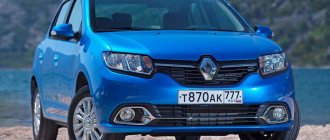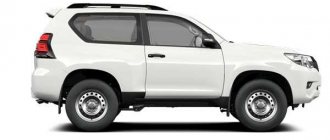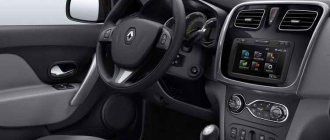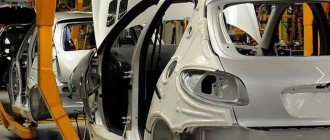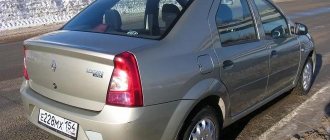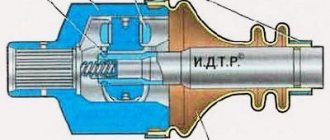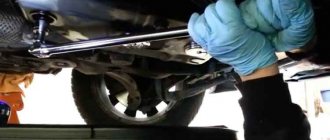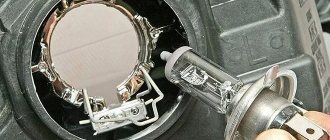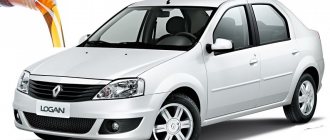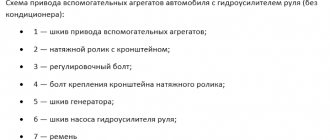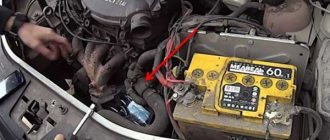Main Renault factories and assembly sites in the world
Renault's country of origin is France. But in Europe, labor is very expensive, and building additional factories on the territory of small France will generally cost enormous sums. Therefore, the corporation uses other opportunities to expand. Either a plant is being built in third world countries, or other enterprises in Europe are being bought out. Thus, the corporation was able to expand its presence in the world, and most budget cars sold in Russia are not assembled in France. The main factories and assembly sites for Renault cars are as follows:
- France – the company’s first and once main plant is located near Paris, which serves for the development and invention of new technologies;
- Romania - the former Dacia corporation is almost entirely owned by the Renault company; all Romanian Dacia factories produce French cars;
- Korea - the Samsung brand is 80% owned by Renault, many production facilities are used for the manufacture of cars;
- Brazil is one of the largest assembly centers for the company's cars, which supplies cars to all Latin American countries;
- Russia - let's start with the fact that Renault owns 50% of the AvtoVAZ company, and some models are assembled at the Avtoframos plant with updated production lines.
It is worth remembering such cooperation as the Renault-Nissan alliance. These are two companies that can boast of their beneficial cooperation. In 2014, this alliance became the fourth largest car manufacturer in the world. Renault owns more than 40 percent of Nissan shares, so the French today have almost complete control over the work and development of this company. However, the competitive environment between these brands remains, since the companies belong to approximately the same segment, each development is a potential competitor for the brotherly concern. Despite all the difficulties, Renault-Nissan cooperation brings many positive aspects in the exchange of technologies and the acquisition of new production capabilities.
In which countries and where is Renault Logan assembled? Are there factories in Russia?
The Renault Logan model is a well-known car that has earned popularity due to its affordable price, European appearance and comparative ease of maintenance.
Most of the cars of this brand are produced in Romania at the Dacia plant, which has been owned by Renault since 1999.
On the territory of the Russian Federation, the first generation of the car was produced for ten years, from 2005 to 2021. In 2014, production was launched at AvtoVAZ, where production of the second generation of cars began.
POPULAR WITH READERS: Renault Kaptur 2021: new options and old prices
Apart from Russia and Romania, Renault Logan is produced in India, but the cars are almost never exported. This producing country is largely focused on domestic needs.
If we talk about the quality of assembly and compare it at different factories, this question is still open and experts do not have a consensus.
Cars produced near Moscow are often praised, because production there is better organized, and the assembly itself is large-scale.
Ready-made components and panels arrive at the plant, so the workers just have to assemble everything into one mechanism and paint the body.
Despite the difference in production approaches, the problems in both cases are identical - squeaks, uneven gaps, metal susceptibility to corrosion, and others. By the way, the considered shortcomings do not manifest themselves on all Logan cars.
Brazil
The history of Renault in Brazil is very interesting. In fact, she has been working in this country together with the American company Willys since 1960. But since 1970, the company left the Brazilian market. She managed to return to this country again and start producing her own cars only in 1997. It is noteworthy that it was in Brazil that the first Renault Megane were produced, which were safely produced until 2012. After this, the plant switched to the production of newer models: “Sandero”, “Master”, “Logan”, “Duster”, “Capture”. In 2015, the first pickup truck was produced based on the Duster car. The Logan car is still produced in Brazil to this day.
A little history
A classic version in a very simple configuration: black bumper, lack of air conditioning and alloy wheels, weak engine, but there is power steering (replacing power steering fluid here, adding oil to Logan’s power steering)!
The following two tabs change content below.
About the expert:
Renault car expert
I own a Renault Megane 2, before that there were Citroens and Peugeots. I work in the service area of a dealership, so I know the car inside and out. You can always contact me for advice.
The first mention of Renault cars in Russia began at the very beginning of the 20th century, when these cars were intended for transportation of the emperor's family.
The first car of LOUIS RENAULT (1898)
And 100 years ago in 1916, in the city of Rybinsk, the Russian Renault joint-stock company was created, and at the same time the construction of the first French concern plant in Russia began, which, after the revolution, was transferred from private ownership to the state.
In the post-war years, the internal policy of the Soviet Union provided for the progress of the automotive industry based on its own developments, but already in the 1960s, Renault’s cooperation with official Moscow was established. Thus, the first representative office of the French auto giant opens on the territory of the USSR. By the beginning of the 70s, the government of the “Soviet” concluded a mutually beneficial contract on the development of the automotive industry, and after 10 years, ¼ of all cars produced were assembled using Renault technologies.
How did Renault appear in Russia?
Nicholas II was skeptical about passenger cars. At the same time, the king had his own trains, his own yacht, but not a car. Until 1903, it was prohibited to use this type of transport in Crimea. However, one day everything changed.
In 1903, the Tsar came to Hesse. The brother of the German Emperor Ernest Ludwig, the Grand Duke of Hesse and the Rhine, who loved cars, knowing the attitude of the Russian Tsar to this transport, could not resist and took a ride with Nicholas II.
The wonderful invention, with its comfort, wisdom and simplicity, made a proper impression and managed to please everyone. Already in 1909, the tsar acquired a garage for his own iron horses. Initially there were only two cars, but by 1914 he had more than 50 cars at his disposal. So he became the owner of the largest number of cars among the rulers of the world at that time.
Five Romanov cars sparkled with Renault nameplates. The king really liked the invention. Mechanical engineering was just developing. The management of the French enterprise was interested in friendship with Russia, and Nicholas II was carried away by the idea and no longer interfered with scientific and technological progress.
In 1916, the Russian Renault joint-stock company appeared on the territory of the Tsarist Empire. A plant was built in Rybinsk on the basis of a state loan, but production of Renault for the Russian market never began here.
After the Great October Socialist Revolution of 1917, the state's friendship with the company ended. The property was nationalized and put into operation for the benefit of the people. In the USSR, at the plant in Rybinsk, they repaired cars and created aircraft engines for many years. The plant was especially important during the war years. It is still intact today, owned by the state by more than 80%, functioning and assembling engines as always.
Renault company and the USSR state
The USSR authorities did not remain indifferent to Renault technologies. These assembled cars were popular and were purchased. But it took a long time before the company was able to implement its policies. In the 60s of the 20th century, a representative office of a foreign enterprise appeared in Moscow.
The continuation of the partnership was the introduction and modernization of mechanical engineering technologies. It was a mutually beneficial process - in the 80s, a quarter of cars produced in the USSR included Renault technologies.
During perestroika, the company changed along with the state - more precisely, it opened its first Moscow office again, in 1992. And in 1998, it signed an agreement to create its own production facilities. The joint venture Avtoframos was created.
It was engaged in the construction of a full-cycle plant, not forgetting about partial assembly. In 2012, all Avtoframos shares ended up in the hands of the Renault concern. The company turned into ZAO Renault Russia. It turned out that Moscow and Togliatti are the cities where Renault is produced in Russia.
In the Russian Federation, only the most modern developments are always used for production. This is a tradition. After all, it was this approach that allowed the company to become popular both among people and among authorities.
She is still no stranger to innovation. Recently, Renault joined forces with the Japanese corporation Nissan, experienced a crisis in connection with this, but managed to get out of a steep dive. Today she is at her best again.
Features of the Russian assembly of Renault Logan
So, Avtoframos, renamed after 2014, decided to work on the OJSC engine plant, which in the past was abandoned already at the final stages of construction. Quite quickly, the company created on its basis a powerful enterprise that today assembles Renault Logan cars. To improve quality, the plant has introduced technology using manual work. At first glance, it seems that quality may suffer from this. In fact, the plant worker is undergoing a training course created by Renault to train its employees in different countries. This is why people act with robotic precision.
As a result, the buyer receives a cheap car with excellent quality, which is confirmed by numerous reviews. By saving on robotic technology, the company can afford to sell Renault Logan at such a low price. At the same time, the plant has a set of modern computer equipment. With its help, it provides protection against possible shortcomings of the assembler.
For example, after the finished model is released, it is sent to a specialized shower designed to test the tightness of joints. This system has been working in Russia for quite a long time. After the shower, the car dries and goes to a small factory track, where it undergoes testing in motion. The plant regularly checks random machines for welding quality.
Assembling Renault Logan cars in Russia
As noted, the main assembly division is. Today it is a powerful and fairly modern enterprise.
In order to improve the quality of the Logan model produced, the plant has introduced manual assembly technology for some important components.
This approach involves special training of employees, as a result of which the company is able to achieve unprecedented coherence in the work process. This allows us to sell cheap and high-quality cars to customers. With all this, the company has a full range of necessary computer equipment. It guards the quality indicators of manufactured cars and is designed to protect the product from the shortcomings of assemblers, that is, to eliminate the negative impact of the human factor on the process.
For example, after the specimen is fully assembled, it is sent to a special “shower” chamber, where the butt joints are tested for their tightness. After taking such a shower, the car is thoroughly washed and then sent to a special factory testing site for testing in motion. In order to check the quality of welded joints, the plant uses a method of partial sampling of random specimens, on which a set of control measures is carried out.
Countries where Renault Sandero is assembled
For the global market, the Renault Sandero model is assembled in several countries. The largest and most powerful enterprise is located in Romania. It is located in the city of Mioveni, in the province of Arges. The production is called Automobile Dacia SA Also, there is a Renault Sandero assembly plant in the city of Casablanca, located in Morocco.
The development of the car began in 2005, and here the model received significant help from Brazilian investors, who purchased new, more powerful equipment for all factories. In Brazil, production is located in the city of Curitiba. The first Renault Sandero rolled off this assembly line in December 2007. In Agrentin, the model began to be sold in February 2008. They deliver it here from Brazil.
In order to adapt the Renault Sandero for the Latin American market, it was necessary to invest 372 million euros. Therefore, production there began in 2007, and even in Romania and Europe the car appeared in 2008, which is remarkable. The last market the car entered was South Africa. This happened in 2009.
Where is Renault Megane assembled?
There are probably no car enthusiasts who have never heard of the Megan model in their lives. The car was first presented to the public in 1996, and since then 3 modifications of the car have already appeared.
The first generation Renault Megane was assembled exclusively at French factories. The second generation, which debuted in 2002, was already assembled in 3 countries, including Turkey, Spain, and, of course, France.
The third generation of Megan, although with short interruptions, is still produced in Moscow.
World premiere
In August 2021, the world premiere of the Renault Arkana crossover took place in the very center of Moscow. The newest car has every chance of becoming a bestseller. The innovation, created almost from scratch, was represented by the top management of the brand’s representative office originally from France, almost in full, headed by Nicolas More.
Although before the demonstration of Arkana there was a phrase about the world premiere, on a planetary scale not everyone will know about the car, because according to the project it was initially a local product. It was developed directly for Russia and taking into account the preferences of car owners in this country.
Production of Renault models in branches
AvtoVAZ and Renault Russia produce the Renault Logan model. Since car factories carry out the entire cycle of work on assembling these cars, their cost is low, which has ensured the high popularity of the cars among Russian consumers. Determining whose build is better is quite difficult. The Moscow plant assembles more slowly, since the process at this car plant is more extensive. AvtoVAZ produces only Renault Logan 2014 models. The main complaints about the products of both manufacturers are: uneven gaps, creaking.
The Renault Sandero and Renault Sandero Stepway models are produced in Russia. These cars have been produced by the Moscow branch of Renault Russia since the very beginning of their appearance. The models are also popular in the domestic market.
The Renault Daster crossover is in high demand not only in Russia, but throughout the world. The popularity of the model determines its production at car factories in India, Brazil and the Moscow branch of Renault Russia.
The elder in the company is Renault Megane. Previously, these models, intended for the Russian market, were produced in their homeland in France in the city of Douai. For other regions, cars were assembled in Spain. When the second generation appeared, the hatchback model began to be assembled in France, the sedan in the Turkish branch, and the station wagon in the Spanish car plant. In Russia, Renault Russia assembles the third generation model.
The Renault Fluence car is also produced by the Moscow Automobile Plant. In addition, these models are supplied to our market from Turkey and South Korea. The country of assembly of Renault Koleos is South Korea, Renault Symbol was previously produced in France, and is now assembled at a Turkish automobile plant. The Renault Kangu model for the Russian market is produced in France.
At the beginning of this year, the Renault-Russia automobile plant began production of the new Renault Captur model with innovative turbine engines.
First restyling of Renault Logan 1
The restyling of the 1st generation Logan was carried out in 2009, and the second generation debuted on the automobile market in 2012.
Logan-2 has been sold in the Russian Federation since March 2014, and although many years have passed since the start of production, the brand has not lost its relevance.
The restyled version of the first model from the French company Renault was produced in sedan, station wagon, pickup and van bodies; only sedans were and are offered to domestic consumers.
Although the car has gained great trust among motorists and is considered “indestructible”, some shortcomings and disadvantages should be noted along with the advantages.
Production of Renault models in branches
AvtoVAZ and Renault Russia produce the Renault Logan model. Since car factories carry out the entire cycle of work on assembling these cars, their cost is low, which has ensured the high popularity of the cars among Russian consumers. Determining whose build is better is quite difficult.
The Moscow plant assembles more slowly, since the process at this car plant is more extensive. AvtoVAZ produces only Renault Logan 2014 models. The main complaints about the products of both manufacturers are: uneven gaps, creaking.
The Renault Sandero and Renault Sandero Stepway models are produced in Russia. These cars have been produced by the Moscow branch of Renault Russia since the very beginning of their appearance. The models are also popular in the domestic market.
The Renault Daster crossover is in high demand not only in Russia, but throughout the world. The popularity of the model determines its production at car factories in India, Brazil and the Moscow branch of Renault Russia.
The elder in the company is Renault Megane. Previously, these models, intended for the Russian market, were produced in their homeland in France in the city of Douai. For other regions, cars were assembled in Spain.
When the second generation appeared, the hatchback model began to be assembled in France, the sedan in the Turkish branch, and the station wagon in the Spanish car plant. In Russia, Renault Russia assembles the third generation model.
The Renault Fluence car is also produced by the Moscow Automobile Plant. In addition, these models are supplied to our market from Turkey and South Korea. The country of assembly of Renault Koleos is South Korea, Renault Symbol was previously produced in France, and is now assembled at a Turkish automobile plant. The Renault Kangu model for the Russian market is produced in France.
At the beginning of this year, the Renault-Russia automobile plant began production of the new Renault Captur model with innovative turbine engines.
Click like, don't be greedy!
September 25, 2015 Auto Fleet Renault Corporation has long become international and has opened a lot of representative offices all over the world. Partnerships with this company often turn into acquisitions, so the current cooperation between Renault and AvtoVAZ is a little alarming. But today is not about that. Let's talk about where and how one of the most successful budget sedans in Russia - Renault Logan - is assembled. This car became the leader of many ratings, received an excellent new generation last year and only slightly raised prices against the backdrop of a general rise in car prices. Therefore, there is every reason to believe that the car will continue to develop significantly in sales and for many buyers will be able to replace plans to purchase the domestic automobile industry. However, Logan also has his own problems, which are directly related to the assembly of the car.
The old generation of Logan was assembled in Moscow, which negatively affected the quality of some elements. This enterprise involves a large amount of manual work and a significant influence of the human factor on the quality of the machine. Therefore, the new generation of Logan in Russia has a slightly different story. Today we will talk not only about where Renault Logan is assembled for Russia, but also in general how widespread this brand has become in the world. This moment turns out to be one of the most interesting aspects of the development of the French concern on Romanian developments.
Logan is the most common model. Russians' favorite
Have you noticed that Renault Logan is quite widespread in our country? They flash on the roads of the country. We have become so accustomed to them that our favorite cars have become like family to us. It's funny, but some women even confuse Logan with Lada Granta. There really are similarities. And many car owners, as well as those who are just looking at the models and want to choose something most suitable, are interested in the question: who makes Renault Logan? Now we'll find out!
First, let's talk a little about the model. This car brand is classified as class “B”, it is a budget car. It is noted that the largest French concern was developing a brand of car just for further export to third world countries. Of course, this does not mean low quality. It’s just that special platforms were used in the production process to achieve a balance of a good level of reliability with affordable cost. That is why most people can easily afford to purchase such a Renault model.
Whose production is Renault Logan? The main base is concentrated in Romania. This is where Dacia, which is a subsidiary, is located. Many years ago, starting in 1999, it became part of Renault.
It’s interesting that car names differ in different countries.
- On the Russian market, as well as in neighboring countries, the car is known as Renault Logan.
- In Latin American countries, in Mexico, the car is known as the Nissan Aprio.
- In India the car is called Mahindra Verito.
- In Morocco, as well as in European countries, the car is known as Dacia Logan.
- In the Middle East, the model is called the Renault Tondar.
In 1998, key technical developments of the model began. Specialists sought to find the optimal solution for developing a family brand of car, not only compact, but also budget-friendly, as accessible as possible. At the same time, the affordable model had to remain reliable, safe, maintain functionality and maintain the prestige of the world's largest automobile concern. No samples were created, limiting ourselves to computer modeling. 2004 was the date of birth of the new Renault. It was then that the car was presented to the public, which became extremely popular. This is a sedan, four-door. For the first time, mass production was opened in Romania.
A little time passed, but it immediately became obvious: the Logan car was becoming the most popular brand in Russia. This is easy to explain, since the model was specially created taking into account the difficult conditions on Russian roads. And the sedan coped with the task perfectly! It satisfied drivers with its technical characteristics, endurance, good maneuverability, and wear resistance of the chassis. The design turned out to be functional, and the cost, despite all its advantages, was pleasingly democratic.
Now Logan is the favorite foreign car in Russia. And many parts and components are produced in Russia! So Reno is already in many ways “ours”, dear. At Russian factories you can find batteries with disks, optics with exhaust systems, dashboards with tires, bumpers with seats for Renault Logan.
Renault is getting closer!
2005 became a landmark year for the “dating” of the domestic auto industry and Renault. The Renault plant in Moscow was officially opened. It was located, making the Avtoframos enterprise its base. Then a series of modernizations followed in 2010 and 2012. All this allowed the plant to develop so much that it began to produce more than 180 thousand cars per year.
Now the company produces not only Logan, but also Duster, Sandero, as well as Latitude and Fluence. The staff began to work at a world-class level of professionalism, and high-tech equipment appeared.
and production of Renault Logan (phase 1 and 2)
Frozen at one time during the final stages of construction, it became the launching pad for the creation of such a powerful enterprise as it is now. To improve the quality of assembly, the plant has introduced production technology using manual labor.
Both Renault Logan and Renault Sandrero are on the assembly line at the same time
To ensure that quality does not suffer from this and only brings benefits, each employee undergoes special training courses created according to international standards. Therefore, people in the enterprise are able to work with the precision and accuracy of robotic machines. All equipment of the enterprise is created with protection against possible employee errors, controlling the work using computer modeling.
This is how Renault Logan cars are assembled at factories in Russia.
Other Renault factories
Renault cars are also created in the following countries:
- Romania - the city of Pitesti. The Romanian plant produces cars for almost the entire European market, but such cars can also be found in Russia. At the moment, the plant is busy manufacturing models from the 2014 model year.
- Brazil - the city of Yuritibe. In a small town in Southern Brazil, the concern creates cars for Latin America.
- Colombia - Envigado. They produce cars mainly for their own market and small exports.
- India - Nasik city. Production is formed for the domestic market and some countries in Asia and Africa.
- Iran - Tehran. After a long five-year break, the Renault concern returned to Tehran and launched production of the Logan and Sandero models. In the near future it is planned to launch production of Renault Quid.
- Russia – AvtoVAZ. The production of Renault cars for Russia has been launched.
- Moscow. The Renault-Russia plant is where most of the models are assembled and production is organized throughout the entire territory of our country.
A few words about Renault
More than a hundred years have passed since the brothers Louis, Fernand and Marcel Renault created their concern. And today the French company ranks 4th in terms of the number of cars produced in the world. Renault was able to achieve such progress thanks to close cooperation with Nissan, forming the Renault-Nissan holding. Therefore, today cars with the French logo are stamped in many parts of the world, and Russia is no exception. Since Renault cars are very popular in our country, the factories here are some of the largest in the world.
This is what the Avtoframos plant in Russia looked like.
The story of Logan and his path in the world assembly
The company presented its development in 2004, then the car was named Dacia Logan, under which it is still sold throughout Europe. In the CIS countries, it was decided to create the brand Renault Logan, and its initial assembly was carried out at a plant in Romania, in the city of Pitesti - at the enterprise of the former Dacia concern, bought by the French. Romanian assembly is of very high quality; the company has completely re-equipped its conveyors and achieved maximum automation. The first Logan in Russia was assembled at Avtoframos, and the second began to be produced in Togliatti at the facilities of AvtoVAZ. There were many reasons for this:
- Avtoframos could not produce the required number of cars for assembly for Russia;
- a large amount of manual labor spoiled the car and reduced its quality;
- training plant employees took a lot of time and required a lot of investment;
- it would be wasteful to introduce modern technologies into an enterprise;
- the budget model has too small a margin to reconstruct the company for it;
- Logan sales of the first model were unstable precisely because of the low rating of the assembly site.
Thus, Renault moved to AvtoVAZ conveyors, which turned out to be more prepared for various assembly processes. After this transformation, the build quality of the second generation Logan increased significantly, which was immediately reflected in user reviews. In 2014, a new generation of Renault Logan for Russia and neighboring CIS countries began to be produced on an assembly line in Tolyatti. Today, this is precisely what allows the corporation to maintain price increases, as well as increase sales, because Logan is fully assembled in our country, and this motivates many patriotic buyers to purchase this particular car model.
Story
Detachment of Renault trucks of the Russian army 1915
Renault Desir Concept.
- 1898 - Brothers Louis, Marcel and Fernand Renault found Société Renault Frères
. On December 24, the company released its first car - the Renault Voiturette 1CV with the world's first gearbox with direct top gear. - 1899 - Société Renault Frères produced the world's first classic car with direct drive to the rear drive wheels (without on-board chains).
- 1902 - Louis Renault applied for a patent for the injection compressor (later it became known as turbocharging).
- 1903 - Marcel Renault dies in a car accident.
- 1904 - Louis Renault patents the design of the world's first removable spark plug.
- 1905 - Louis Renault creates the world's first compressed air starter.
- 1908 - Fernand Renault sells his share of the company's shares to Louis.
- 1917 - Louis Renault creates the world's first classical tank - the Renault FT.
- 1922 - The world's first brake booster was used on the Renault 40CV.
- 1932 - Autorail VH produces the world's first diesel railcar.
- 1935 - Renault produces the most successful French tank of the interwar period - the Renault R35.
- 1944 - Louis Renault dies in prison after being arrested on charges of collaborating with the Nazis during World War II. Three months after his death, the French government nationalizes the company.
- 1948 - The Renault 4CV, a rear-engine subcompact sedan, a competitor to the Citroen 2CV, Fiat 600 and Volkswagen 1200, goes on sale.
- 1965 - Renault launches production of the world's first hatchback - Renault 16 (1966 car in Europe).
- 1979 - To enter the American car market, Renault buys a 22.5% stake in American Motors (AMC).
- 1983 - Production of the licensed Renault Alliance model (Renault 9) begins in the USA.
- 1985 - Launch of Renault Espace, the first European minivan.
- 1987 - Renault sells its stake in AMC to Chrysler.
- 1990 - The Renault 5 is replaced by the Renault Clio, the first model with a non-digital name, European Car of the Year in 1991 (first generation) and 2006 (third generation). Clio is still in production (fifth generation).
- 1996 - The company is again privatized and is now called Renault SA.
- 1999 - Renault buys 99% of the shares of the Romanian company Dacia, and also acquires 36.8% of Nissan in exchange for 15% of its shares. Renault vice-president Carlos Ghosn has been transferred to Nissan, as a result of which the Japanese company, which was on the verge of bankruptcy, was brought out of a severe crisis.
- 2001 - Renault sells its truck division (Renault Véhicules Industriels) to Volvo. Such large cars are purchased by https://sga-buy.ru/ after assessment by specialists, even if the vehicle is not found.
- 2002 - The Formula 1 team Benetton Renault receives the official name Renault F1, in 2005 and 2006 this team wins the championship both in the individual championship and in the constructors' championship. Renault increases its stake in Nissan.
- 2005 - Carlos Ghosn becomes president of the company.
- 2008 - Renault acquired a blocking stake in AvtoVAZ OJSC (25%).
- 2011 - Renault launches a line of electric vehicles: Fluence ZE, Kangoo ZE, Twizy and ZOE.
- 2012 - Renault-Nissan enters into an agreement to gain control of AvtoVAZ by purchasing a 67.13% stake in the company.
- 2015 — The millionth car rolls off the assembly line at the Renault plant in Moscow.
Safety
In Euro NCAP crash tests, many production Renault models received the highest rating of 5 stars. The assessment was carried out according to the safety criteria of the driver, front passenger, rear row passengers, safety of children and pedestrians:
- 2002 - Renault Megane II and Renault Vel Satis
- 2003 - Renault Scenic, Renault Espace and Renault Laguna
- 2004 - Renault Megane II Coupe Cabriolet and Renault Modus
- 2005 - Renault Clio III and Renault Vel Satis
2007 - Renault Laguna II New
Renault Clio RS
2008 - Renault Koleos and Renault Megane II New
- 2009 - Renault Grand Scenic
- 2012 - Renault Clio IV
- 2013 - Renault Captur
- 2013 - Renault ZOE
- 2014 - Renault Espace V
What comes from where and how is it produced?
Sometimes our brother, the automotive man in the street, engages in banter, claiming that what our domestic auto industry can do besides welding tank hulls and armored personnel carriers?
Well, let’s say, they say, the French will teach our “specialists” to weld the bodies of Renault cars, but everything else, right down to the screws, as well as paint and primer, are supplied exclusively from Champagne, or from some other French province . Ours are not even able to paint the body!
Consider the rigmarole with Logan (assembled at that time by Avtoframos), when in 2005 the first hundred of these cars were rejected even by our car enthusiasts, accustomed to all surprises and shortcomings, because of rust that appeared almost from the first trip. Well, here we go, they say, Logan is rotten through and through!
The bourgeoisie came in large numbers and began to sort it out. It turns out that the bourgeois paint did not adhere to our domestic primer.
And engines of Spanish origin, by the way, also had problems.
But it’s okay, our national peculiarity lies in the fact that at least at a trough, but at least this trough leaves the gate, and then everything, down to the bolt, will be twisted, remade and completely forgotten.
On one assembly line, three models are currently being assembled simultaneously - these are Kaptur, Duster and Arcana. The French have perfected the technology for changing equipment, as they say “on the fly”, without stopping the conveyor. And for this we had to:
- – change a third of the welding equipment;
- – install robots for welding both floors and side members;
- – modernize the painting complex to work with two colors of paint at once;
- – additionally set up control posts.
As for control, this is, first of all, checking the body geometry, welds and paint quality.
The localization percentage of Renault Arcana, or the indicator of assembly parts and assemblies manufactured at Russian facilities, is about 70 percent, as reported by one of the managers, namely Jerome Pano.
India
In 2008, Renault began building its first car assembly plant in India. In just 21 months, the first production of Renault cars was established. And although the Logan car is not yet produced in this country, other brands are quickly gaining popularity. To consolidate its success, the company decides to open its first design studio in Mumbai. This is the fifth studio worldwide.
Since 2005, the Renault Kwid model was launched. This unique urban crossover model was created exclusively for India. The car is very budget-friendly, its price is only $3,900. This model has become available to the country's middle class. According to the director of AvtoVAZ, this model may appear on Russian roads in the near future.
New Renault models in Russia
For the French company, the Russian automotive market is one of the key ones. That is why the leaders of the Renault concern pay a lot of attention to our country.
In mid-March 2021, a magnificent and representative event took place at which the new Renault Kaptur crossover was officially shown. Renault Captur is specially created for Russian car enthusiasts. There are a number of differences between the Captur for Russia and the Captur that is offered in Europe.
Renault Captur will be assembled at the Moscow Renault plant, and it will go on sale towards the end of summer 2021.
In addition, by 2021, the automaker promises to introduce a new generation of the popular Duster model to the Russian market. Renault constructors and designers are putting a lot of effort into ensuring that the third generation of Duster can please drivers all over the world no worse than the same Renault Captur. It is already known that there will be significant changes in the technical component of the model.
Quality of Russian assembly and comparison with other options
Logan is assembled in seven factories around the world, located in Romania, Morocco, Brazil, India, Iran, Colombia and Russia. This is a budget car, which it was decided to leave for developing countries, but the Romanian assembly has actively begun sales in Europe. Against the background of the general financial crisis, the new generation Logan managed to overtake Volkswagen in sales in Germany, which no other car had achieved before.
The Russian assembly of the second generation Renault Logan is practically no different in quality from the Romanian one, which is considered the standard. In Brazil, Colombia and other exotic countries, the company assembles Logans at old factories without much modernization, so their quality leaves much to be desired. The features of the Russian car assembly are as follows:
- Logan in our version is made from the same materials as the European version;
- on an assembly line in Togliatti, the French implemented an automatic assembly complex for a car;
- the concern supplied foreign inspectors and controllers who certify the quality of each stage of work;
- each car unit is tested before entering showrooms;
- the cars have surprisingly high-quality interior assembly, hard plastic does not creak or fall apart;
- all the parts know their place, the car owner will not have any questions about the assembly;
- The power unit and gearbox are supplied from Romania; large-scale assembly of the car is carried out at AvtoVAZ.
Despite such similar features of Russian and Romanian assembly, in Russia they use different technology. The engine remains the same from the first generation, but in Europe Logan is sold with 0.9 and 1.2 liter power units. The price of the car in Europe started in 2012 at 6.5 thousand euros, which was the reason for such extensive sales in the Old World. In Logan, the manufacturer combined several aspirations of the European mentality - the desire for practicality, low price and low fuel consumption. It was these features that influenced car sales in some European countries. By the way, today Logan was removed from European sales.
Features of Renault Logan
Photo: Renault assembly in Russia
Among the main advantages of the model, I would like to note excellent handling, attractive appearance and low cost.
The main task of the designers was to fit within the price range - no more than 5 thousand euros. The savings are mainly noticeable on interior trim materials and individual exterior elements.
Due to the fact that Renault Logan is very popular in Ukraine and Russia, it is designed taking into account domestic road conditions. The vehicle's ground clearance is 15.5 cm. Also, a modernized suspension with increased strength is used.
Engines produced at domestic facilities comply with all European environmental standards.
The maximum speed of the car is set in the range from 160 to 180 km/h, and depends on the installed motor.
Video: the entire assembly cycle of Renault Logan in Russia
Origins
The brand owes its birth and successful development to Louis Renault, who founded it back in 1898 together with his brothers. After only two years of the company’s existence, production volumes had grown so much that it was necessary to involve more production lines in the assembly, and then an agreement was concluded with a Belgian plant, which began assembling French cars. In addition to producing production cars, Renault also created sports cars that took part in races and brought many victories. The constant development of the company and compliance with the needs of consumers of that time allowed it to stay afloat during the First World War. Renault taxi models Taxi La Marne even erected a monument for the prompt transportation of soldiers to the Marne River in 1914, thanks to which the French were able to win and prevent German troops from taking over the capital. In addition, Renault Freres produced aircraft engines and ships for the army, and a tank was also designed.
Renault has presented the world with not a single iconic car, and each of them has its own story. By 1929, the car brand was represented in 49 countries, which was considered a huge achievement at that time.
The Second World War caused serious damage to Renault Freres - as a result of the fighting, several factories were destroyed, Louis Renault himself was accused of assisting the Nazis and arrested, and died in October 1944. After the war in 1945, the company was nationalized by the French government and became known as Renault. The factories were reconstructed, and Renault cars continued to improve and conquer countries in different parts of the world, receiving numerous awards and universal recognition.
Today, the products of the Renault automobile corporation are extremely popular, including in Russia, where the production of cars of this brand is actively underway. The cooperation of the Renault Brothers with the Russian Empire marked the beginning of a long friendship that continues throughout the history of Renault, despite government reforms and changes in power in the company.
Wide range of models. One homeland - many “addresses”!
Let's talk more about Renault? What models is this concern ready to offer on the world market? We see that a successful project, opened back in 1899 in France, gradually turned into a luxurious business that glorified the founding brothers all over the world. At the moment, the popularity and level of profitability of the concern is only steadily increasing. Renault became a partner of Nissan. The two companies are united into the largest holding. Now it is difficult to immediately answer which country produces Renault, because cars of this brand are successfully and massively assembled on different continents, in different countries. To tell where a car is from, you need to know the specific model.
Now Renault has also become the most influential partner of AvtoVAZ. After all, Renault now owns a quarter of the shares of the largest domestic car manufacturer.
Experts have identified several factories that produce Renault in different parts of the world.
- AvtoVAZ produces cars for Russian consumers.
- The European market is predominantly supplied with cars from the Romanian plant. In Russia there are also Romanian-assembled cars.
- Cars no longer reach Russian car enthusiasts from the Brazilian plant.
- There is another domestic plant located near Moscow. A huge number of Renaults for Russia are produced here.
- Renault cars come to Africa, Asian countries, and India from a large Indian automobile plant.
Obviously, Renault is already so widespread in the world that cars are produced in different countries. The assembly location of a particular brand depends on what roads it is currently driven on.
Second generation Renault Logan in Tolyatti
The second generation Renault Logan, presented to the general public in May 2014, also retained all the best qualities of its older brother, however, its serial production was established and continues to this day at the AvtoVAZ plant in Tolyatti.
At the moment, both generations of the car are being produced, high demand in the market and a small loss in price over time have made it very popular in our market.
Hi all!
Recently, the Renault-Russia plant (formerly Avtoframos) stopped producing the first generation Logan model. On Friday, December 18, the last first-generation Logan rolled off the assembly line of the Moscow plant. It was a car in the Authentic configuration, white, with a base 1.4-liter engine producing 75 horsepower. In total, more than 550 thousand cars of this model were produced; the first generation Logan was produced at the Avtoframos plant (later Renault-Russia) for more than 10 years, since April 2005.
From now on, only the second generation Logan will be offered. Well, we are developing, the automobile market is no exception, we need to move forward, this is normal. After all, the model has been produced only here in Russia for more than 10 years, and Logan was officially introduced in 2004. I could be wrong, but I think they will continue to assemble the first generation Logan in other countries under other brands.
Since December 18, the first generation Logan has sunk into history. An entire era passed with him. The era of updating the Russian vehicle fleet with new budget foreign cars.
The French, by releasing this model to the market, proved to the whole world (and AvtoVAZ in particular) that it can be inexpensive, practical and reliable. Back then, back in 2005, it was never thought that this unsightly, ugly sedan could become a bestseller on the Russian market. This car gave many Russian drivers the opportunity to switch to a foreign car (just a foreign car), and saved them from many problems.
Logan became a model of reliability and unpretentiousness in its class, became a real people's car and workhorse, miserably throwing Avtovaz out of these positions. “A car for 5,000 euros” was eagerly awaited, they eagerly read Auto Review reviews and comparisons with AvtoVAZ’s then new Kalina, they lined up for the “Russian Renault,” but Avtoframos’ production facilities could not provide everyone with a brand new car at once.
Logan firmly occupied his niche and became familiar. Its design no longer seems striking to anyone. Although now, the first phase already stands out with its chisel design against the background of modern slick, soapy cars.
The Logan platform gave birth to many other models, I don’t think it’s worth listing examples. He became the best friend of taxi drivers, couriers and other people who use the car for work. The car has accumulated impressive mileage, and the durability of Logan’s engines and the indestructibility of the suspension are still the stuff of legends.
Actually, now it is almost impossible to find a used Logan, especially one that has not been in a taxi in the first phase. The car faithfully served families whose budget allowed them to purchase only the brainchild of Avtovaz, thanks to its spacious interior and trunk.
Actually, it was then that the French showed the world what a budget car should be: roomy, practical, reliable, unpretentious, simple and inexpensive to maintain. And the success of the model was gigantic. The car was also produced in Romania under the Dacia brand, and in India under the Mahindra brand, and somewhere else under the Nissan brand (correct me).
Of course, there were some drawbacks. Non-folding seats, trunk hinges, leaking oil seals and quickly failing steering ends, ignition coils and thermostats have become the talk of the town. But all these disadvantages were eliminated and treated quickly, and were more than compensated for by the advantages of the machine.
And how much debate there was about whether the quality dropped after 2009 or not. There were persistent rumors that the Logans of the first phase were distinguished by higher reliability than the restyled ones, various stories were cited as examples, etc.
I don't know for sure. The bottom line remains the same: we have ushered in another automobile era. The current Logan will not repeat the success of its predecessor and owes its reputation precisely to that unsightly, angular sedan that was criticized as best they could, but was loved no less.
And finally, a couple of photos - a meeting of generations
Renault Group
(in Russian
Renault
) is a French automobile manufacturing corporation. The company's headquarters are located in Boulogne-Billancourt, near Paris. Part of the Renault-Nissan-Mitsubishi Alliance.
Features of the Renault Logan project in Russia in 2015
If you want to buy a quality car of European origin, but are not ready to pay a lot of money, it’s time to take a closer look at the Renault Logan. This is a car that is definitely worth the money, since the base price of the model in Russia in 2015 is 420,000 rubles. For this money, you can easily order a car from a dealer in the basic configuration, but more expensive configurations are often available. Despite such cheapness, the basic Logan even has some comfort features that domestically produced competitors do not have. The main features of the Russian-assembled machine are as follows:
- the 1.6-liter engine with 8 or 16 valves remained in the basic version and the only representative of the model;
- the potential of the power unit is 82 and 102 horsepower - quite adequate power for this body;
- Transmissions include a standard five-speed manual, as well as a simple 4-range automatic;
- four trim levels offer an excellent choice of cars for every potential buyer;
- the most expensive Logan will cost almost 700,000 rubles in Russia, and this does not take into account some additional options;
- the transport proves to be reliable since all suspensions and parts are designed for the conditions of developing countries.
When a concern prepares a car for the markets of developing countries, all parts are used with increased strength and a long service life, because this is the only way to provide a guarantee for the standard 100,000 kilometers. Otherwise, the company will constantly carry out warranty repairs of the machine. In the new Russian Logan there are no problems with this point - all parts work perfectly, no serious warranty claims or returns of cars to the dealer have been recorded. However, minor problems and shortcomings do occur, and this is not so strange considering the cost of the car and its origin. We invite you to watch an honest test drive of Logan:
Links
Official website of Renault in Russia
| Renault cars since 1980 | ||||||||||||||||||||||||||||||||
| Class | 1980s | 1990s | 2000s | 2010s | ||||||||||||||||||||||||||||
| 1 | 2 | 3 | 4 | 5 | 6 | 7 | 8 | 9 | 1 | 2 | 3 | 4 | 5 | 6 | 7 | 8 | 9 | 1 | 2 | 3 | 4 | 5 | 6 | 7 | 8 | 9 | 1 | 2 | 3 | 4 | 5 | 6 |
| Extra small | Twingo | Twingo II | Twingo III | |||||||||||||||||||||||||||||
| Small | Super 5 | Clio I | Clio II | Clio III | Clio IV | |||||||||||||||||||||||||||
| Symbol I | Symbol II | Symbol III | ||||||||||||||||||||||||||||||
| Logan I | Logan II | |||||||||||||||||||||||||||||||
| Sandero | Sandero II | |||||||||||||||||||||||||||||||
| Small III group | 14 | 9 / 11 | Megane I | Megane II | Megane III | Megane IV | ||||||||||||||||||||||||||
| Fluence | ||||||||||||||||||||||||||||||||
| Average | 18 | Laguna I | Laguna II | Laguna III | Talisman | |||||||||||||||||||||||||||
| Big | 20 / 30 | Safrane | Vel Satis | Latitude | ||||||||||||||||||||||||||||
| LAV | Kangoo | Kangoo II | ||||||||||||||||||||||||||||||
| Mini crossover | Captur | |||||||||||||||||||||||||||||||
| Compact crossover | Kadjar | |||||||||||||||||||||||||||||||
| Koleos I | Koleos II | |||||||||||||||||||||||||||||||
| Duster | ||||||||||||||||||||||||||||||||
| Kaptur | ||||||||||||||||||||||||||||||||
| Subcompact van | Modus | |||||||||||||||||||||||||||||||
| Compact van | Scene I | Scénic II | Scénic III | Scénic IV | ||||||||||||||||||||||||||||
| Minivan | Espace I | Espace II | Espace III | Espace IV | Espace V | |||||||||||||||||||||||||||
| Coupe | Fuego | Avantime | Laguna Coupe | |||||||||||||||||||||||||||||
| Roadster | Spider | Wind |
Let's sum it up
A high-quality Renault Logan car assembled in Russia remains affordable and surprisingly pleasant to use. The car fully meets the requirements of the modern world; the design of the exterior and interior is on par with world leaders. The style of the new generation of Renault cars has been transferred to this budget B-class sedan.
Now the Sandero shares its appearance with this model, differing only in the rear part of the hatchback body. It is interesting that the authentic design of cars cannot yet be imitated, and the Renault corporation itself claims that they will soon completely change the style.
Before we had time to get used to the new look of Renault Logan, the designers promised new items and changes in style. But for now, this version of the car is available in showrooms, which completely suits even the most demanding buyers about the appearance of the car. This is what makes so many people prefer this car.
Considering the low cost and significant success around the world, we can conclude that Logan is worth your purchase. What do you think of one of the most successful budget sedans in the world?
Which cars have a galvanized body?
The car body can be completely galvanized or only partially galvanized. Cars with predominantly galvanized bodies are produced by automakers such as Audi, BMW, Volkswagen, and Porsche.
Currently reading: Technical characteristics and equipment of Dacia Logan, 2nd generation (2012 – 2016)
If we consider specific models of cars with a galvanized body, we can name the following: So you need to be more careful when purchasing a galvanized car. Now many German, American, French, and Japanese cars have galvanized bodies. Although skeptics believe that a galvanized body is more difficult to paint.
Sometimes only the thresholds, bottoms, and bottoms of doors are galvanized.
The list of such cars is large, we can mention the Chevrolet Lacetti, many Skoda, Volkswagen models. Of course, Audi has the best galvanized bodies - double-sided galvanic zinc coating of the entire body.
The technology is quite complex; not all manufacturers can reproduce this technology correctly.
There are quite a lot of cars with galvanized bodies! There are still cars among expensive foreign cars: Audi A 6 (1994 - 1997), BMW, Porsche, Volkswagen Gol3, for example. There are, of course, more budget car options.
For example, Renault Logan (very popular), Chevrolet, Peugeot (best of all 307). And you can also buy the same car, only used, but in excellent condition.
If the price doesn’t stop you, take the cars listed above. I heard that the old golfs are galvanized, and Izha Oda seems to be the same, they say that Toyota is also galvanized. During the USSR, the legendary Volga GAZ 21 had a galvanized body!
Since 1998, almost all European manufacturers have switched to producing cars with galvanized bodies or at least the most vulnerable parts.
As far as I know, the manufacturers quot;Audiquot; became pioneers in this matter.
Today you can often find the characteristic of a galvanized body in the description of a car. But in reality it turns out that not every body is actually treated with zinc. Usually some part is galvanized.
But only some models are completely treated with zinc; they can last quite a long time. This list is divided into cars that were galvanized: Volvo, all cars starting from model 240, Chevrolet Lacetti, Fiat Albea, Opel Vectra, Opel Astra. Almost all manufacturers, except Russian and Chinese, have been making only galvanized bodies for about 15 years.
So just don't buy old cars or cheap Russian and Chinese ones.
Then there will definitely be no problems with the body.
